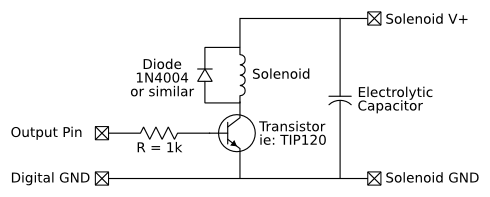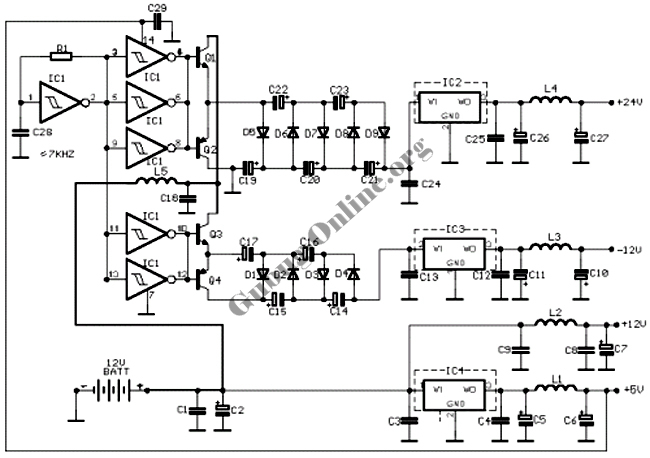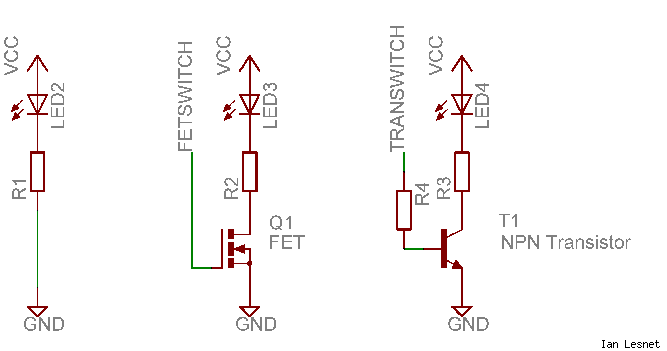
Keyboard Matrix Interface

Keyboards can be classified into two categories based on the connection method of the switches: those with a common connection and those arranged in a matrix. The matrix type offers the significant advantage of minimizing the number of connections, making it ideal for integrated circuits (ICs) designed for matrix keyboards. However, many keyboards are available in bulk that, in addition to a common connection, have individual connectors for each key. These keyboards can be interfaced with ICs that require a matrix configuration using a series of electronic switches. The principle is simple: each key of the keyboard activates an electronic switch within the matrix. For instance, a hexadecimal keyboard can be organized in a 4x4 matrix configuration. Each electronic switch is maintained in the open position by a pull-down resistor. The circuit's current draw is minimal, primarily influenced by the pull-down resistor values and the number of keys pressed. CMOS switches, in particular, consume virtually no current.
Keyboards can be categorized based on their switch connection methodology into two main types: common connection keyboards and matrix connection keyboards. The matrix configuration is particularly advantageous as it significantly reduces the number of required connections, which is beneficial for integration with various integrated circuits (ICs) specifically designed to interface with matrix keyboards.
In contrast, keyboards with a common connection often feature individual connectors for each key, presenting a different challenge when interfacing with ICs that are optimized for matrix configurations. To bridge this gap, electronic switches are utilized. Each key on the keyboard effectively controls one of these electronic switches, which are arranged in a matrix layout.
For example, a hexadecimal keyboard can be structured as a 4x4 matrix, where each position in the matrix corresponds to a specific key. The electronic switches in this configuration are typically held in an open state by pull-down resistors, which ensure that the switches do not inadvertently close and create false signals. The current drawn by this arrangement is minimal and is predominantly determined by the resistance values of the pull-down resistors and the number of keys that are simultaneously pressed.
Notably, CMOS (Complementary Metal-Oxide-Semiconductor) switches are particularly well-suited for this application due to their extremely low power consumption, effectively drawing negligible current during operation. This characteristic makes them ideal for battery-powered devices, where power efficiency is paramount. The combination of matrix switch arrangement and low-power CMOS technology thus creates an efficient and effective keyboard interface solution. Keyboards can be slotted into two categories, at least as far as the manner that the switches are connected is co ncerned: those with a common connection and those with the switches arranged in a matrix. The matrix type has the important advantage that the number of connections is an absolute minimum. Such an arrangement is ideal for ICs; many of these are designed for use with a matrix keyboard. However, many keyboards are available in job lots, for instance, that apart from a common connection also have a connector for each key. Such keyboards can be connected to ICs that require a matrix type with the aid of a number of electronic switches.
The principle is straightforward: each key of the keyboard controls an electronic switch that is included in a matrix. As an example, the diagram shows a hexadecimal keyboard that is arranged in a 4- -4 matrix. Each of the electronic switches is held in the open position by a pull-down resistor. The current drawn by the circuit is very small and is determined mainly by the value of the pull-down resistors and the number of keys being pressed.
The CMOS switches draw virtually no current.
Keyboards can be categorized based on their switch connection methodology into two main types: common connection keyboards and matrix connection keyboards. The matrix configuration is particularly advantageous as it significantly reduces the number of required connections, which is beneficial for integration with various integrated circuits (ICs) specifically designed to interface with matrix keyboards.
In contrast, keyboards with a common connection often feature individual connectors for each key, presenting a different challenge when interfacing with ICs that are optimized for matrix configurations. To bridge this gap, electronic switches are utilized. Each key on the keyboard effectively controls one of these electronic switches, which are arranged in a matrix layout.
For example, a hexadecimal keyboard can be structured as a 4x4 matrix, where each position in the matrix corresponds to a specific key. The electronic switches in this configuration are typically held in an open state by pull-down resistors, which ensure that the switches do not inadvertently close and create false signals. The current drawn by this arrangement is minimal and is predominantly determined by the resistance values of the pull-down resistors and the number of keys that are simultaneously pressed.
Notably, CMOS (Complementary Metal-Oxide-Semiconductor) switches are particularly well-suited for this application due to their extremely low power consumption, effectively drawing negligible current during operation. This characteristic makes them ideal for battery-powered devices, where power efficiency is paramount. The combination of matrix switch arrangement and low-power CMOS technology thus creates an efficient and effective keyboard interface solution. Keyboards can be slotted into two categories, at least as far as the manner that the switches are connected is co ncerned: those with a common connection and those with the switches arranged in a matrix. The matrix type has the important advantage that the number of connections is an absolute minimum. Such an arrangement is ideal for ICs; many of these are designed for use with a matrix keyboard. However, many keyboards are available in job lots, for instance, that apart from a common connection also have a connector for each key. Such keyboards can be connected to ICs that require a matrix type with the aid of a number of electronic switches.
The principle is straightforward: each key of the keyboard controls an electronic switch that is included in a matrix. As an example, the diagram shows a hexadecimal keyboard that is arranged in a 4- -4 matrix. Each of the electronic switches is held in the open position by a pull-down resistor. The current drawn by the circuit is very small and is determined mainly by the value of the pull-down resistors and the number of keys being pressed.
The CMOS switches draw virtually no current.





